Recent presidents’ increased reliance on unilateral action has triggered cries of a new imperial presidency and warnings of an authoritarian tilt in American politics (Ackerman Reference Ackerman2010; Levitsky and Ziblatt Reference Levitsky and Ziblatt2018). Because the formal institutional checks exercised by Congress and the courts are weak (Howell Reference Howell2003; Moe and Howell Reference Moe and Howell1999), some argue that public opinion has become the most important constraint on presidential unilateralism (e.g., Posner and Vermeule Reference Posner and Vermeule2010).Footnote 1
An emerging literature shows that presidents risk provoking a popular backlash when going over Congress’ heads and changing policy unilaterally (Reeves and Rogowski Reference Reeves and Rogowski2015, Reference Reeves and Rogowski2016, Reference Reeves and Rogowski2018; Lowande and Gray Reference Lowande and Gray2017), particularly when their actions provoke pushback from Congress or the courts (Christenson and Kriner Reference Christenson and Kriner2017b, Reference Christenson and Kriner2017c). However, none of these studies has shown empirically that public opinion systematically influences presidents’ exercise of their unilateral authority.
We investigate whether the president’s public approval rating affects the frequency with which presidents advance their policy agendas unilaterally. Because the relationship between approval and executive action is potentially endogenous, we employ vector autoregression coupled with Granger-causality tests of the relationship between two prominent measures of significant executive orders and presidential approval over more than six decades. We find that popular presidents issue more significant executive orders than do unpopular presidents, and, accordingly, do not suffer public opinion backlashes from them. When contemplating unilateral action, presidents do more than anticipate the likelihood of a formal rebuke from Congress or the courts. Rather, they also appear to consider the political costs of acting alone and often forgo executive action when they lack broad support among the public.
PRESIDENTIAL APPROVAL AND UNILATERAL ACTION
When contemplating unilateral action, presidents weigh the immediate and almost certain policy benefits of acting unilaterally against the anticipated long-term costs of going it alone. One of the most salient political costs is the risk of alienating public opinion. Public support can be a critically important resource when bargaining with Congress (e.g., Beckmann Reference Beckmann2010; Canes-Wrone and De Marchi Reference Canes-Wrone and De Marchi2002). Executive action to advance one policy priority unilaterally may prove a Pyrrhic victory if it weakens the president’s capacity to achieve important items on his legislative agenda. In addition to jeopardizing congressional cooperation, an erosion in popular support can also embolden the president’s congressional opponents to use nonlegislative tools, including investigative oversight, to push back on administration policies and further weaken the administration’s political position (Kriner and Schickler Reference Kriner and Schickler2014). Finally, the president’s standing among the public also has important electoral ramifications. Popular presidents are more likely to secure reelection for themselves and to boost the fortunes of a would-be co-partisan successor (e.g., Abramowitz Reference Abramowitz2016). Both are critical to defending a president’s unilateral legacy from being undone with the stroke of a pen by the next president.
When anticipating the public’s reaction to and the attendant political costs of executive action, presidents have strong incentives to consider their overall job approval. Job approval is one of the most important predictors of support for unilateral action (Reeves and Rogowski Reference Reeves and Rogowski2015; Christenson and Kriner Reference Christenson and Kriner2017a). Popular presidents enjoy greater support for their executive actions, all else equal, than unpopular presidents. Moreover, the reaction of Congress and the courts critically influences public support for unilateral action (Christenson and Kriner Reference Christenson and Kriner2017b, Reference Christenson and Kriner2017c). These actors are significantly less likely to push back against popular presidents than unpopular presidents (Howell Reference Howell2003).Footnote 2 Thus, on average, presidents who enjoy strong approval ratings anticipate fewer political costs from taking bold unilateral action than do their peers who lack a broad base of public support. This underlies the political constraint hypothesis: increases in presidential approval will produce a corresponding increase in the frequency of significant executive orders.
Notably, this hypothesis, derived from an emphasis on political costs, starkly contrasts with the strategic model of unilateral action (for an overview, see Deering and Maltzman Reference Deering and Maltzman1999), which contends that presidents will disproportionately resort to unilateralism when their prospects for legislative success are dim. This alternate logic generates the competing evasion hypothesis: increases in presidential approval will produce a corresponding decrease in the frequency of significant executive orders.
Reverse causality is always possible in relationships between elite action and public opinion. Indeed, recent experimental work suggests that the causal arrow may also run in the opposite direction (Reeves and Rogowski Reference Reeves and Rogowski2018). However, if presidents correctly anticipate public reactions and forgo unilateral action when the public is unlikely to rally behind it, then we should find little evidence of systematic backlashes in the observational data. Thus, there is good reason to expect a null hypothesis here, which we call the no backlash hypothesis: increases in significant executive orders will not have a systematic effect on presidential approval.
DATA
To test our hypothesis that public approval constrains presidents’ use of important executive orders, we focus on the correspondence between their actual issuance and presidential approval dynamics over long periods of time.Footnote 3 Presidents have issued more than 3,000 executive orders since the early 1950s. However, the vast majority of these orders were routine. Therefore, scholars have developed a variety of approaches to identify significant executive orders (e.g., Chiou and Rothenberg Reference Chiou and Rothenberg2014; Mayer Reference Mayer1999; Mayer and Price Reference Mayer and Price2002; Warber Reference Warber2006). Our analysis incorporates data from two different approaches.
First, we update work by Howell (Reference Howell2005) to construct a count of significant executive orders issued between 1953 and 2018. We code as significant any executive order that received coverage in the New York Times within one year of its issuance.Footnote 4 This allows us to focus on orders that achieved at least some measure of public salience. We plot the issuance of significant executive orders by month in Figure 1. Over this time period, the average number of executive orders per month is 1.1, with a standard deviation of 1.4.
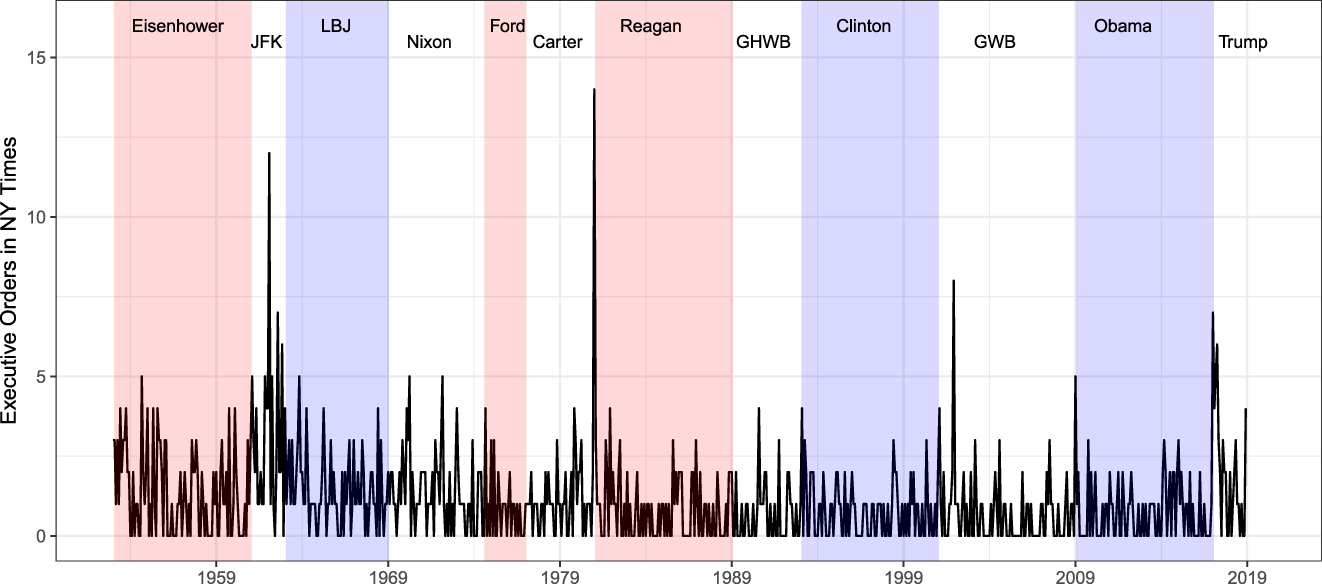
FIGURE 1. Monthly Executive Orders in the NY Times
We also employ a second measure of executive order significance created by Chiou and Rothenberg (Reference Chiou and Rothenberg2014). This continuous score is based on a Bayesian hierarchical item response theory (IRT) model of coverage (e.g., historical overviews, newspapers, magazines, and law reviews) of executive orders before 2003. In the analyses that follow, we first scaled the significance score to have a minimum of zero and a positive range, and then summed the score for each order in each month to create an index of executive order intensity. The range for this measure, plotted in Figure 2, is 0 to 51.6, with a mean of 4.9 and standard deviation of 4.0.Footnote 5
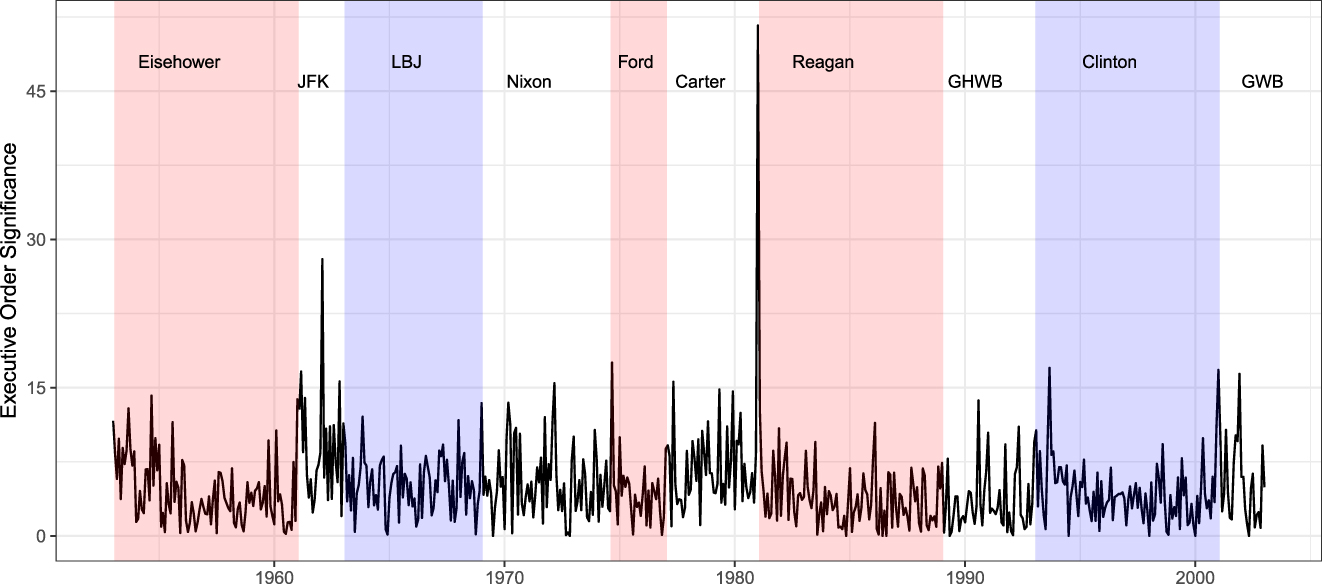
FIGURE 2. Monthly Executive Order Significance via IRT Model
For both series, we merge the executive orders data with presidential approval data. To construct a measure of monthly presidential approval, we used all available Gallup job approval data compiled by the American Presidency Project. We then used Kalman filtering to fill several gaps in the monthly time series, particularly in the 1950s (Green, Gerber, and De Boef Reference Green, Gerber and De Boef2001). Figure 3 plots the percent approving of the president. Overall, the mean of the series across this period is 53.4%, with a standard deviation of 11.8%.
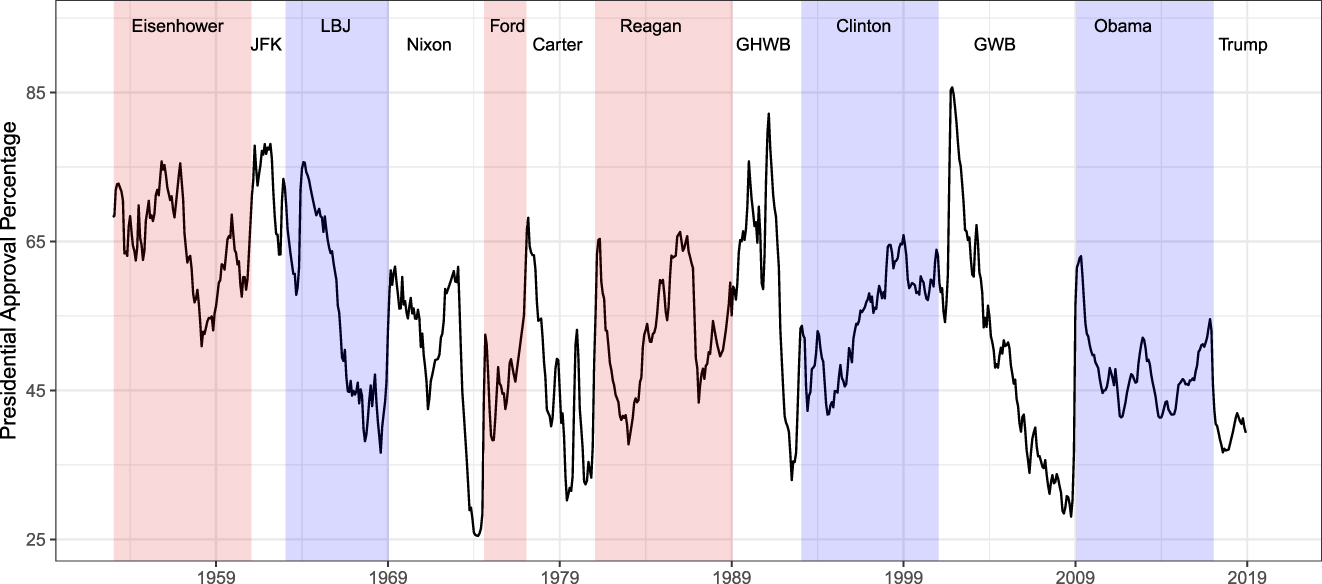
FIGURE 3. Monthly Presidential Approval
METHODS
Presidency scholars have long examined the factors driving temporal variation in presidential use of executive orders (e.g., Bolton and Thrower Reference Bolton and Thrower2016; Howell Reference Howell2003; Krause and Cohen Reference Krause and Cohen1997). Analyses of the relationship between approval and executive order issuance have yielded decidedly mixed results (Deering and Maltzman Reference Deering and Maltzman1999; Fine and Warber Reference Fine and Warber2012; Gleiber and Shull Reference Gleiber and Shull1992; Krause and Cohen Reference Krause and Cohen1997; Marshall and Pacelle Jr. Reference Marshall and Pacelle2005; Mayer and Price Reference Mayer and Price2002). Critically, these earlier studies modeled the relationship in the same way: by including a measure of approval on the right side of the regression equation. None endeavored to explicitly account for the potential endogeneity in the relationship between approval and the frequency of unilateral action.
The possibility of simultaneity between orders and opinion demands a modeling strategy that allows for the possibility of an endogenous relationship. To this end, we utilize a vector autoregressive (VAR) model (Sims Reference Sims1980).Footnote 6 Unlike structural equation models, the VAR does not impose structural relationships a priori, which reduces the likelihood of omitted variable bias and misspecification (Freeman, Williams, and Lin Reference Freeman, Williams and Lin1989). The VAR also allows for the specification of strictly exogenous variables. In particular, the election of a new president—as presidents may have different inclinations toward unilateral behavior—may affect the system of endogenous relationships. To account for this, our models include a series of presidential fixed effects (Krause and Cohen Reference Krause and Cohen2000). We also controlled for other exogenous variables. First, a central prediction of the strategic model is that presidents will increasingly resort to unilateral action when they confront a hostile Congress (e.g., Deering and Maltzman Reference Deering and Maltzman1999; Mayer Reference Mayer1999). Accordingly, our models include a dummy variable for divided government. Second, because prior work suggests that presidents are more apt to act unilaterally when politically weakened by a bad economy (Krause and Cohen Reference Krause and Cohen1997, Reference Krause and Cohen2000), our models include the index of consumer sentiment. Third, because prior analyses have examined whether unilateralism increases in war time (Howell Reference Howell2003), our models include a dummy variable indicating periods when the United States was engaged in Korea, Vietnam, the Persian Gulf War, Afghanistan, or Iraq. Finally, to account for the possibility that trends in significant executive action are triggered by the enactment of major legislation, we include a control for the number of landmark laws enacted in a given month (Mayhew Reference Mayhew1991).Footnote 7
In the results that follow, we rely on Granger-causality tests of the relationships between presidential approval and significant executive orders as specified by their corresponding VAR models. The concept of Granger-causality is based on prediction such that a variable can be said to “Granger-cause” another variable if the former’s past values help predict those of the latter, beyond what its past values do alone (see Freeman Reference Freeman1983; Granger Reference Granger1969). The null hypothesis that the endogenous variable does not Granger-cause the exogenous one can therefore be tested via Wald tests that the VAR coefficients on all the lags of the endogenous variable are jointly zero.
RESULTS
The results of the Granger-causality tests are presented in Table 1. We estimate separate models for each measure of executive order significance. The left side of Table 1 presents results from the model using the NYT–based count of significant executive orders. In the approval equation, we test whether the coefficients on the two lags of executive orders are jointly zero. The null hypothesis that executive orders do not Granger-cause approval cannot be rejected, confirming the no backlash hypothesis. In the orders equation, we test the potential for approval to affect executive orders. Here, we are able to reject the null hypothesis that the two lags of approval do not Granger-cause executive orders. In sum, while there appears to be little effect of executive orders on approval, the reverse is not true, with approval having a significant effect on executive orders.
TABLE 1. Granger–Causality Tests

Note: *p < 0.05.
The right side of Table 1 presents results from the model using the summed continuous executive order significance score. As in the previous model, we are unable to reject the null hypothesis that executive orders do not Granger-cause approval. However, we are able to reject the null hypothesis that the two lags of approval do not Granger-cause executive orders. In sum, we again find evidence for a single causal direction, with approval having a significant positive effect on executive orders, but not vice versa.
In order to interpret the magnitude of the causal effects uncovered in the Granger-causality tests, we calculate the respective impulse response functions (IRF). These functions simulate a shock to the system of relationships in the VAR and trace out the effect of the shock on the endogenous variables (see, e.g., Lütkepohl Reference Lütkepohl2005; Hamilton Reference Hamilton1994). Because the error terms in the VAR are correlated, we orthogonalize the shocks in the VAR—that is, we Cholesky decompose the reduced-form errors in the VAR into mutually uncorrelated shocks.
We calculate both the orthogonalized IRF (OIRF) and the cumulative orthogonalized IRF (COIRF). The former displays the impact of a single point in time impulse—an unexpected one-time one standard deviation shock to the system. The latter adds the effect of the shocks in the previous periods for each new period, thereby illustrating how the accumulation of a persistent shock affects the system over time; that is, it illustrates the effect of an unexpected but long-lasting shock. While both are informative, they each have their interpretive advantages. For example, the former allows us to see how a one-time bump in approval that returns to the pre-bump level the next month affects the issuance of executive orders at each of the subsequent months. The latter, however, shows us the effect on the issuance of executive orders when approval bumps up and stays up over the subsequent months.
Figure 4 plots the results of the impulse response functions for the model of the count of executive orders. The IRF, the solid line in the figure, shows that a one standard deviation impulse in presidential approval, about 12%, results in an immediate 0.13 point bump in the number of executive orders. The effect steadily but slowly returns to zero over the next several months—one month out the effect is 0.1, at two months 0.07, and at three 0.05—with the confidence interval overlapping zero in the fifth month. While the effect from the impulse appears substantively small, it is nontrivial, given the low mean on significant orders, only about one per month. Moreover, it shows that even a blip on approval emboldens, if only mildly, a president to act more unilaterally for a few months.
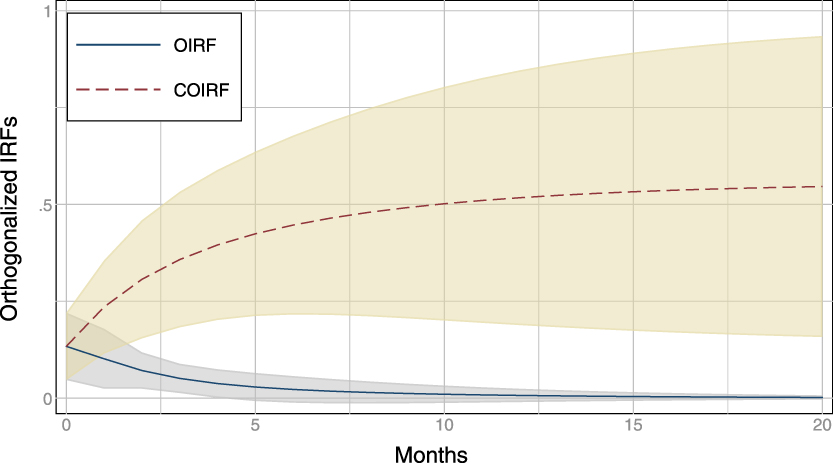
FIGURE 4. Impulse Response Functions for Executive Order Count
What is more likely in practice, and perhaps more interesting, than such a blip, is a persistent change in presidential approval. A president who sees her poll numbers rise and stay put for several months may be particularly encouraged to use unilateral action. The long-run or total effect of the impulse illustrated in the COIRF illustrates precisely this scenario. This is the effect on the number of significant executive orders of a single one standard deviation shock in approval that is maintained for each of the following 20 months.
As we can see from the dashed line in Figure 4, the persistent shock leads to increasingly more executive orders over time, although the returns are diminishing with a 0.4 bump in orders by the fourth month that moves over 0.5 at the tenth month and to 0.55 by the twentieth month where it levels off. Thus, after the eighth month, we see on average a half more significant executive orders each month provided that the president maintains her bump in approval. Over a couple of years at this approval level then, we should expect to see about 12 more significant executive orders. As a result, the evidence strongly supports our political constraint hypothesis and not the evasion hypothesis of the strategic model.
Figure 5 plots the results of the impulse response functions for the model of the IRT executive order significance scores. Immediately apparent is a general similarity in patterns across the IRFs, despite the different indicators of significant executive action measured on different scales. For the OIRF, a one standard deviation impulse in presidential approval results in an immediate 0.56 point bump in the executive order significance score. The effect of the one-time shock diminishes at a similarly slow rate in this system, hitting zero at four months, with the confidence interval overlapping zero by three months.
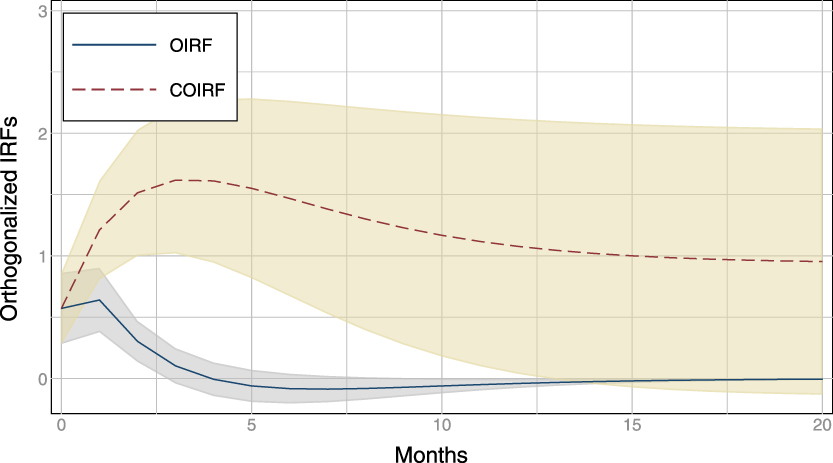
FIGURE 5. Impulse Response Functions for Executive Order Significance
The impact of a persistent gain in presidential approval on executive orders is shown in the COIRF, the dashed line in Figure 5. The standard deviation impulse in approval leads to fast gains in executive order significance, with substantial growth in the first three months. In the first month, the significance score effect more than doubles from 0.57 to 1.21, reaching as high as 1.62 in the third month, before slowly moving down to 1.1 in the first year, and settling at 0.95 at 20 months. Thus, on average, across this period, we should expect to see approximately a one point (i.e., approximately a 0.25 standard deviation) increase in executive order significance each month due to the change in approval.
DISCUSSION
This study presents the first systematic evidence that public opinion constrains presidents’ exercise of their unilateral powers. Across two different measures of significant unilateral activity, we find that increases in approval embolden presidents to issue important unilateral directives. By contrast, decreases in approval heighten the risks of political pushback and encourage presidents to forgo opportunities to move policy unilaterally. These results challenge the venerable strategic model of unilateral action, arguing that presidents resort to unilateralism when their political position is weak. They also speak to important debates on executive accountability. While recent research warns that presidents often seek to manipulate rather than respond to the public’s policy preferences (Druckman and Jacobs Reference Druckman and Jacobs2015), presidents nonetheless appear wary of executive action when it threatens to erode their base of popular support.
But is this popular check a sufficient safeguard against executive aggrandizement? Whether a popular check can bolster the “guardrails” of the separation of powers system (Levitsky and Ziblatt Reference Levitsky and Ziblatt2018) may critically depend on how polarization affects Americans’ assessments of unilateral action. Partisan polarization has only further crippled the already weak check afforded by Congress. It also risks eroding the popular constraint.Footnote 8 If increasing partisan loyalties calcify partisan divisions in public opinion, it is possible that even brazen assertions of unilateral power will fail to stir up enough public opposition to dissuade future abuse. As a result, the willingness of political elites from the president’s own party to break rank and publicly condemn abuses of unilateral power may become even more critical to activating a public check.
In this respect, it is notable the extent to which the first two years of the Trump administration are outliers. On the one hand, Trump’s frequent recourse to unilateral action despite historically low approval ratings sharply conflicts with more than sixty years of precedent. And while we find little evidence that major executive orders systematically lower presidential approval, the stark unpopularity of Trump’s boldest gambits may have contributed to his low approval ratings, despite presiding over a robust economy. On the other hand, consistent with theory, many of Trump’s actions have provoked intense pushback, even from prominent Republicans. Ultimately, recent politics remind us that unlike institutional checks and balances, the popular constraint on unilateralism remains informal. There is little the public can do to constrain a unilateral president determined to ignore the vox populi, except to exercise its power at the ballot box.
SUPPLEMENTARY MATERIAL
To view supplementary material for this article, please visit https://doi.org/10.1017/S0003055419000327.
Replication materials can be found on Dataverse at: https://doi.org/10.7910/DVN/UHUK4P.









Comments
No Comments have been published for this article.